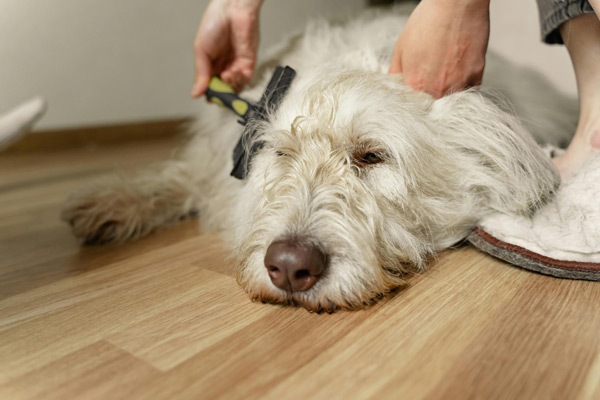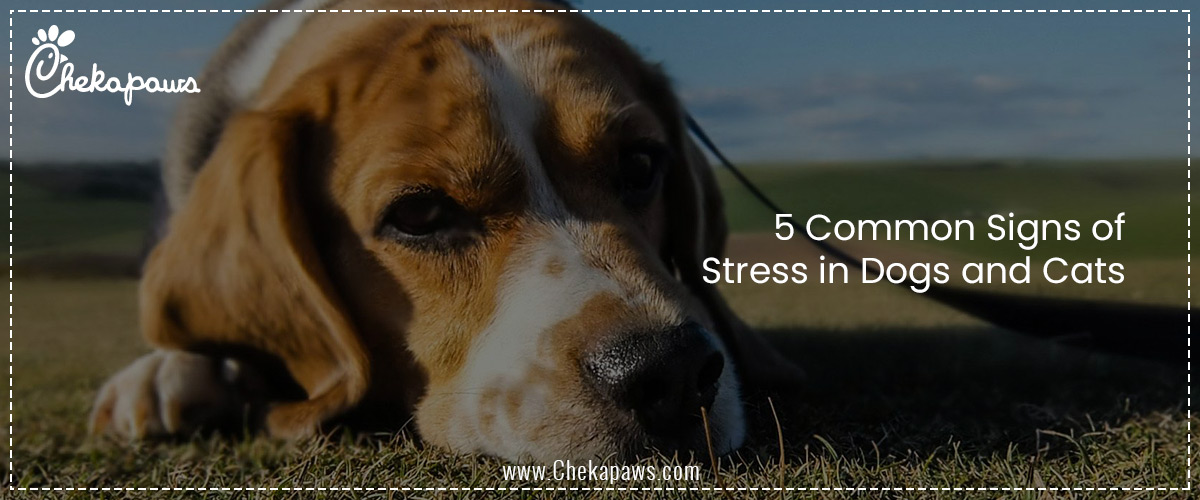As pet owners, we know that our furry friends are important members of our families. Stress affects dogs and cats much like it does people, and if it is not managed, it can cause major behavioral and health problems. Our furry friends’ inability to express their emotions verbally presents a problem. Rather, they use subtle physical and behavioral indicators to convey their discomfort. It is essential to recognize these symptoms in order to protect their mental and physical health.
Depending on their personalities, environments, and past experiences, dogs and cats may exhibit stress in different ways. While some act out, others withdraw. Early detection of these changes enables pet owners to react correctly, halting the stress from developing into more serious issues down the road. This post will discuss five typical symptoms of stress in cats and dogs and offer helpful suggestions for making your pet feel comfortable and protected.
Table of Contents

Changes in Appetite
A change in eating patterns is among the first and most obvious symptoms of stress in both cats and dogs. Emotion and physical states are intimately related to appetite. A pet’s regular food schedule may be disturbed when they are under stress.
In dogs: When under stress, dogs may eat much less or, in certain situations, more than normal. A dog may be experiencing anxiety or panic if they abruptly stop eating or start picking at their food. As a coping strategy, some dogs may also acquire pica, a disorder in which they devour non-food items. On the other hand, if food makes a stressed dog feel better, they may stress-eat.
In cats: It is well known that cats are extremely sensitive to environmental changes. When their pattern is disturbed, such as when they move to a new home or get a new pet, a stressed-out cat may stop eating altogether. Early care is essential for cats experiencing appetite loss since it can rapidly result in hepatic lipidosis, often known as fatty liver disease, a hazardous condition.
Root Causes
- Changes in the surroundings (new house, new child, new pet)
- Anxiety related to separation
- Lack of stimulation or boredom
- Pain or illness (often made worse by stress)
What You Can Do
- Maintain a regular feeding schedule.
- Establish a calm, secure dining space.
- To temporarily increase appetite, provide favourite foods or treats.
- If decreased appetite persists for more than a day or two, see a veterinarian.
Your pet’s appetite can often be restored by assisting them in feeling safe and getting back to their regular routine. Consistency and patience are essential.
Excessive Grooming or Poor Grooming
Pet grooming habits can be a powerful window into a pet’s emotional state. Grooming habits may noticeably change as a result of stress.
Over-grooming in cats: When under stress, cats may lick or chew parts of their bodies obsessively, which can occasionally result in bald spots or skin irritation. Psychogenic alopecia is the term for this behaviour, which is sometimes confused with flea allergy or skin conditions. Loud noises, changes in the home, or the death of a partner are common triggers.
Dogs and Self-Soothing Behaviors: As a kind of self-soothing, dogs may scratch or lick their paws excessively. Although excessive licking that causes blisters or hair loss frequently indicates underlying anxiety, some licking is normal.
Distinguishing Stress from Medical Issues
- First, rule out allergies, parasites, or skin disorders.
- Check for additional indications of anxiousness in conjunction with grooming behavior.
- Keep an eye out for instances where the behavior gets worse, such as storms or being left alone.
Tips for Intervention
- Increase physical and cerebral stimulation with puzzles, walks, and playing.
- Make use of relaxing tools like anxiety wraps or pheromone diffusers.
- Establish a steady setting with calm areas or hiding places.
- If behaviors continue, think about getting professional behavior treatment.
Stress-related pet grooming behaviors can be considerably decreased by keeping a caring, orderly environment.
Aggression or Withdrawal
An unexpected decrease in a pet’s friendliness, such as becoming aggressive or overly reclusive, is another important indicator of stress.
Stress-induced aggression in dogs and cats can take the form of growling, hissing, snapping, or biting. This frequently stems from fear. For example, if a dog feels cornered or intimidated, they may become violent. A cat that is overstimulated or afraid may swat and hiss.
Withdrawal and Avoidance: Whereas a gregarious cat may completely shun contact, an extroverted dog may start hiding beneath furniture. A pet that exhibits this type of withdrawal is typically overwhelmed.
Potential Stress Triggers
- Noisy surroundings
- Unknown guests
- Death of a pet companion
- Health problems
How to Help a Pet Who Is Aggressive or Withdrawn
- Correcting the behavior will only make it worse.
- Establish a schedule that is quiet and dependable.
- Provide secure areas for your pet to hide out.
- Restore confidence by using constructive criticism.
If aggression continues, consult a behaviorist or trainer.
Managing stress-related behavioral changes in your pet requires you to understand and respect their boundaries while also boosting their self-esteem.
Destructive Behavior or Litter Box Accidents
Pets frequently express stress by acting defiantly, but in reality, they are pleading for assistance.
Dogs who engage in destructive behavior may chew furniture, dig through rubbish, or both. These actions frequently occur when a dog is not given enough mental stimulation or is left alone for an extended period of time.
Cats and Improper Elimination: Cats rarely urinate outside of the litter box out of animosity. Common causes include stressful stimuli such a filthy litter box, territorial battles, or changes in the home.
Understanding the Behavior
- These behaviors let go of stored-up tension or energy.
- They might be an effort to regain control or self-soothe.
- Frequently happens when routines abruptly shift.
How to Proceed
- Make sure your pet receives a lot of mental and physical stimulation.
- Litter boxes should be kept in calm places and cleaned often.
- Think about interactive feeders or puzzle toys.
- Redirect and reward calm behaviours instead than punishing them.
Consistent, kind attention can change even the most disruptive behaviors with time and understanding.
Physical Symptoms: Shaking, Panting, Vomiting, or Diarrhea
A pet’s body can suffer greatly from stress, which might show up as physical signs that could be mistaken for disease.
In dogs, trembling, shaking, and excessive panting—which are not related to exercise or heat—are frequently signs of stress or anxiety. Anxiety can sometimes cause diarrhoea or vomiting, particularly during travel or fireworks.
In cats: Stress can cause cats to drool, throw up, or have digestive problems. Events such as trips to the veterinarian or noisy construction going on close by may coincide with these symptoms.
When to seek Veterinary Help
- If symptoms last longer than twenty-four hours
- If fatigue or loss of appetite accompany physical complaints
- If there is a suspicion of underlying diseases, such as infections
Coping Mechanisms
- Establish a calm, safe space.
- Make use of white noise or soothing music.
- Try anti-anxiety drugs or vitamins that have been recommended by a veterinarian.
- Use desensitisation strategies for recognized stressors.
Quickly treating physical symptoms brought on by stress enhances your pet’s quality of life and helps prevent long-term health problems.
How to Help Your Pet in Stress Management
It takes patience, empathy, and persistence to create a stress-free environment for pets. The following are important methods to help your dog or cat
- Keep a Routine: Schedules that are predictable help people feel less anxious.
- Offer Enrichment: Interactive play, puzzles, and toys help people become less bored.
- Make Use of Comfort Items: Toys, blankets, and pheromones can all help reduce anxiety.
- Train Positively: Reward composed actions rather than punishing them.
- Track Changes: To identify trends, record behavioral changes in a journal.
- Seek Professional Assistance: If you need advice, don’t be afraid to speak with behaviorists or veterinarians.
You can create a loving atmosphere where your pet feels safe, loved, and understood by taking some proactive measures.
Conclusion
Even for pets, stress is an inevitable aspect of life. Early detection of the symptoms can have a significant impact on their happiness and general health. Each behaviour is your pet’s way of expressing concern, ranging from subtle changes in grooming and appetite to more obvious indicators like hostility or physical disease.
You may confidently assist your pet in navigating their stress by remaining perceptive, sympathetic, and knowledgeable. By doing this, you fortify your relationship with them and guarantee that they lead a happy, safe, and comfortable existence.







